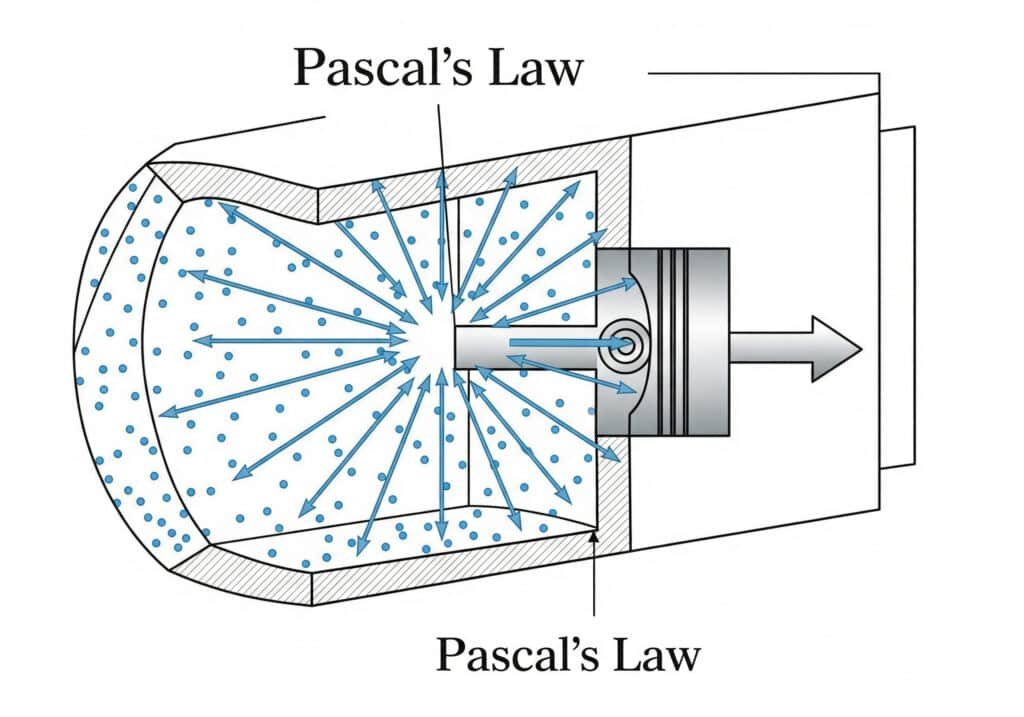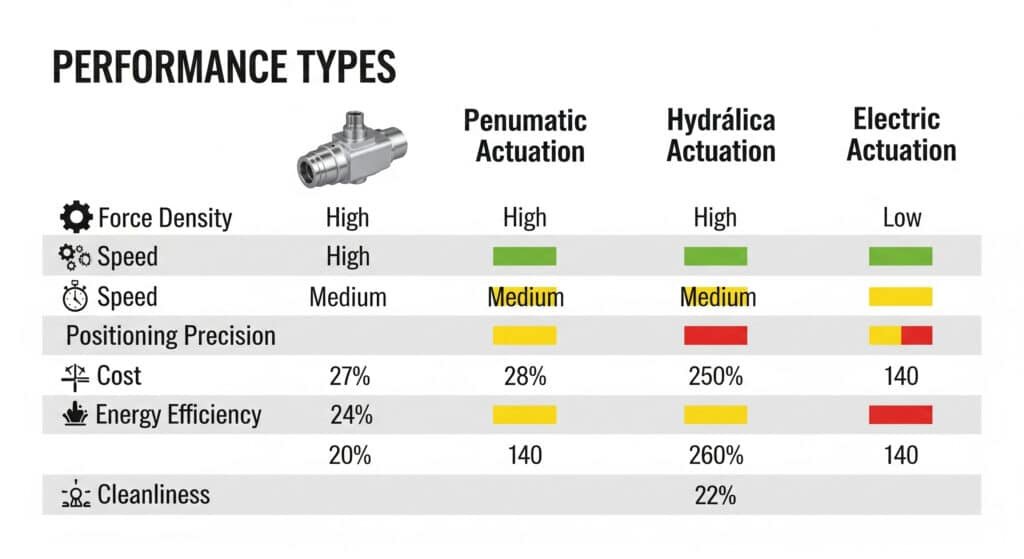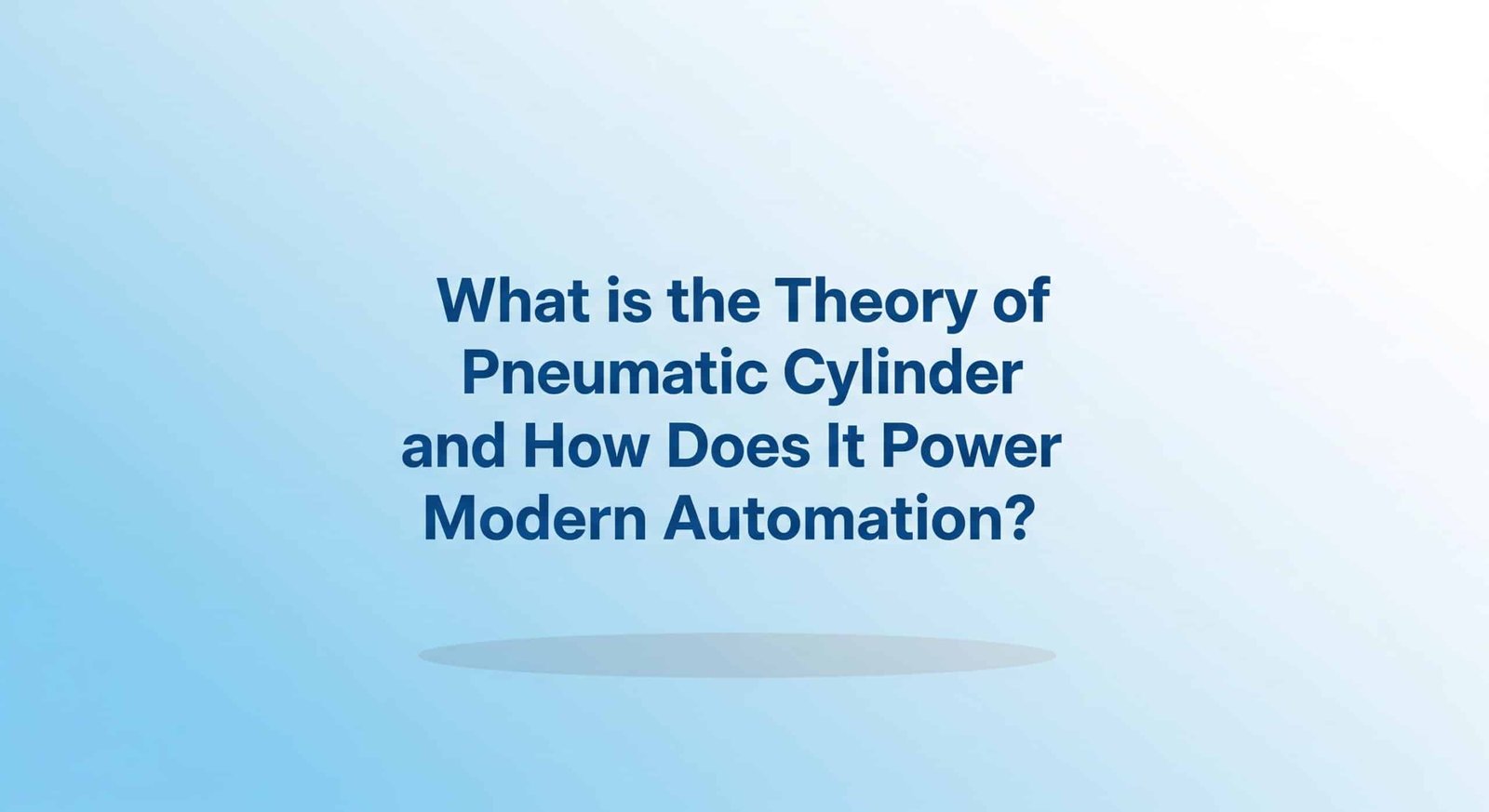Manufacturing downtime costs companies millions annually. Pneumatic cylinders power 80% of industrial automation systems. Yet many engineers don’t fully understand the underlying physics that make these systems so reliable and efficient.
Pneumatic cylinder theory is based on Pascal’s Law, where compressed air pressure acts equally in all directions within a sealed chamber, converting pneumatic energy into mechanical linear or rotary motion through pressure differentials.
Two years ago, I worked with a British engineer named James Thompson from Manchester whose production line kept failing. His team didn’t understand why their pneumatic system lost power intermittently. After explaining the fundamental theory, we identified pressure drop issues that saved his company £200,000 in lost production.
Table of Contents
- What Are the Fundamental Physics Behind Pneumatic Cylinders?
- How Do Pressure Differentials Create Motion in Pneumatic Systems?
- What Are the Key Components That Make Pneumatic Theory Work?
- How Do Different Pneumatic Cylinder Types Apply These Principles?
- What Factors Affect Pneumatic Cylinder Performance Theory?
- How Does Pneumatic Theory Compare to Hydraulic and Electric Systems?
- Conclusion
- FAQs About Pneumatic Cylinder Theory
What Are the Fundamental Physics Behind Pneumatic Cylinders?
Pneumatic cylinders operate on basic physics principles that have powered industrial automation for over a century. Understanding these fundamentals helps engineers design better systems and troubleshoot problems effectively.
Pneumatic cylinders work through Pascal’s Law, Boyle’s Law, and Newton’s Laws of Motion1, converting compressed air energy into mechanical force through pressure differentials across piston surfaces.

Pascal’s Law Application
Pascal’s Law states that pressure applied to a confined fluid transmits equally in all directions. In pneumatic cylinders, this means compressed air pressure acts uniformly across the entire piston surface area.
The fundamental force equation is: Force = Pressure × Area
For a 4-inch diameter cylinder at 100 PSI:
- Piston area = π × (2)² = 12.57 square inches
- Force output = 100 PSI × 12.57 = 1,257 pounds
Boyle’s Law and Air Compression
Boyle’s Law explains how air volume changes with pressure at constant temperature. This principle governs how compressed air stores energy and releases it during cylinder operation.
When air compresses from atmospheric pressure (14.7 PSI) to 114.7 PSI (absolute), its volume reduces by approximately 87%. This compressed air stores potential energy that converts to kinetic energy during cylinder extension.
Newton’s Laws in Pneumatic Motion
Newton’s Second Law (F = ma) determines cylinder acceleration and speed. Higher pressure differentials create greater forces, resulting in faster acceleration until friction and load resistance balance the driving force.
Key Physics Relationships:
| Law | Application | Formula | Impact on Performance |
|---|---|---|---|
| Pascal’s Law | Force generation | F = P × A | Determines maximum force |
| Boyle’s Law | Air compression | P₁V₁ = P₂V₂ | Affects energy storage |
| Newton’s 2nd | Motion dynamics | F = ma | Controls speed/acceleration |
| Conservation of Energy | Efficiency | Ein = Eout + Losses | Determines system efficiency |
How Do Pressure Differentials Create Motion in Pneumatic Systems?
Pressure differentials are the driving force behind all pneumatic cylinder motion. The greater the pressure difference across the piston, the more force and speed the cylinder generates.
Motion occurs when compressed air enters one cylinder chamber while the opposite chamber vents to atmosphere, creating a pressure differential that drives piston movement along the cylinder bore.
Single-Acting Cylinder Theory
Single-acting cylinders use compressed air in only one direction. A spring or gravity returns the piston to its original position when air pressure releases.
The effective force calculation must account for spring resistance:
Net Force = (Pressure × Area) – Spring Force – Friction
Spring force typically ranges from 10-30% of maximum cylinder force, reducing overall output but ensuring reliable return motion.
Double-Acting Cylinder Theory
Double-acting cylinders use compressed air for both extension and retraction. This design provides maximum force in both directions and precise control over piston position.
Force Calculations for Double-Acting Cylinders:
Extension Force: F = P × (Full Piston Area)
Retraction Force: F = P × (Full Piston Area – Rod Area)
The rod area reduction means retraction force is always less than extension force. For a 4-inch cylinder with 1-inch rod:
- Extension area: 12.57 square inches
- Retraction area: 12.57 – 0.785 = 11.785 square inches
- Force difference: approximately 6% less on retraction
Pressure Drop Theory
Pressure drops2 occur throughout pneumatic systems due to friction, fittings, and valve restrictions. These losses directly reduce cylinder performance and must be considered in system design.
Common pressure drop sources:
- Air lines: 1-3 PSI per 100 feet
- Fittings: 0.5-2 PSI each
- Valves: 2-8 PSI depending on design
- Filters: 1-5 PSI when clean
What Are the Key Components That Make Pneumatic Theory Work?
Pneumatic cylinder theory relies on precisely engineered components working together. Each component serves a specific function in converting compressed air energy into mechanical motion.
Essential components include the cylinder barrel, piston assembly, rod, seals, and end caps, each designed to contain pressure, guide motion, and transfer force efficiently.
Cylinder Barrel Engineering
The cylinder barrel must withstand internal pressure while maintaining precise bore dimensions. Most industrial cylinders use seamless steel or aluminum tubing with honed internal surfaces3.
Barrel Specifications:
| Material | Pressure Rating | Surface Finish | Typical Applications |
|---|---|---|---|
| Aluminum | Up to 250 PSI | 16-32 Ra | Light duty, food grade |
| Steel | Up to 500 PSI | 8-16 Ra | Heavy duty, high pressure |
| Stainless Steel | Up to 300 PSI | 8-32 Ra | Corrosive environments |
Piston Design Theory
Pistons transfer pressure force to the rod while sealing the two air chambers. The piston design affects cylinder efficiency, speed, and service life.
Modern pistons use multiple sealing elements:
- Primary Seal: Prevents air leakage between chambers
- Wear Rings: Guide piston movement and prevent metal contact
- Secondary Seals: Backup sealing for critical applications
Sealing System Theory
Seals are critical for maintaining pressure differentials. Seal failure is the most common cause of pneumatic cylinder problems in industrial applications.
Seal Performance Factors:
- Material Selection: Must resist air permeation and wear
- Groove Design: Proper dimensions prevent seal extrusion
- Surface Finish: Smooth surfaces reduce seal wear
- Operating Pressure: Higher pressures require specialized seal designs
How Do Different Pneumatic Cylinder Types Apply These Principles?
Various pneumatic cylinder designs apply the same basic theory but optimize performance for specific applications. Understanding these variations helps engineers select appropriate solutions.
Different cylinder types modify basic pneumatic theory through specialized designs like rodless cylinders, rotary actuators, and multi-position cylinders, each optimizing force, speed, or motion characteristics.
Rodless Pneumatic Cylinder
Rodless cylinders4 Theory
eliminate the traditional piston rod, allowing longer strokes in compact spaces. They use magnetic coupling or cable systems to transfer motion outside the cylinder.
Magnetic Coupling Design:
The internal piston contains permanent magnets that couple with an external carriage through the cylinder wall. This design prevents air leakage while transferring full piston force.
Force Transfer Efficiency: 95-98% with proper magnetic coupling
Maximum Stroke: Limited only by cylinder length, up to 20+ feet
Speed Capability: Up to 60 inches per second depending on load
Rotary Actuator Theory
Rotary pneumatic actuators5 convert linear piston motion into rotary motion through gear mechanisms or vane designs. These systems apply pneumatic theory to create precise angular positioning.
Vane-Type Rotary Actuators:
Compressed air acts on a vane within a cylindrical chamber, creating rotational torque. The torque calculation follows: Torque = Pressure × Vane Area × Radius
Multi-Position Cylinder Theory
Multi-position cylinders use multiple air chambers to create intermediate stopping positions. This design applies pneumatic theory with complex valve systems for precise positioning control.
Common configurations include:
- Three-position: Two intermediate stops plus full extension
- Five-position: Four intermediate stops plus full stroke
- Variable position: Infinite positioning with servo valve control
What Factors Affect Pneumatic Cylinder Performance Theory?
Multiple factors influence how well pneumatic theory translates into real-world performance. Understanding these variables helps engineers optimize system design and troubleshoot problems.
Key performance factors include air quality, temperature variations, load characteristics, mounting methods, and system pressure stability, all of which can significantly impact theoretical performance.
Air Quality Impact on Theory
Compressed air quality directly affects pneumatic cylinder performance and service life. Contaminated air causes seal wear, corrosion, and reduced efficiency.
Air Quality Standards:
| Contaminant | Maximum Level | Impact on Performance |
|---|---|---|
| Moisture | -40°F dew point | Prevents corrosion and freezing |
| Oil | 1 mg/m³ | Reduces seal degradation |
| Particles | 5 microns | Prevents wear and sticking |
Temperature Effects on Pneumatic Theory
Temperature changes affect air density, pressure, and component dimensions. These variations can significantly impact cylinder performance in extreme environments.
Temperature Compensation Formula: P₂ = P₁ × (T₂/T₁)
For every 100°F temperature increase, air pressure increases approximately 20% if volume remains constant. This affects force output and must be considered in system design.
Load Characteristics and Dynamic Forces
Static and dynamic loads affect cylinder performance differently. Dynamic loads create additional forces that must be overcome during acceleration and deceleration phases.
Dynamic Force Analysis:
- Acceleration Force: F = ma (mass × acceleration)
- Friction Force: Typically 10-20% of applied load
- Inertial Forces: Significant at high speeds or with heavy loads
I recently helped an American manufacturer named Robert Chen in Detroit optimize his pneumatic system for heavy automotive parts. By analyzing dynamic forces, we reduced cycle time by 30% while improving positioning accuracy.
System Pressure Stability
Pressure fluctuations affect cylinder performance consistency. Proper air treatment and storage help maintain stable operating conditions.
Pressure Stability Requirements:
- Pressure Variation: Should not exceed ±5% for consistent performance
- Receiver Tank Size: 5-10 gallons per CFM of air consumption
- Pressure Regulation: Within ±1 PSI for precision applications
How Does Pneumatic Theory Compare to Hydraulic and Electric Systems?
Pneumatic theory offers distinct advantages and limitations compared to other power transmission methods. Understanding these differences helps engineers select optimal solutions for specific applications.
Pneumatic systems provide fast response, simple control, and clean operation but with lower force density and less precise positioning compared to hydraulic and electric alternatives.

Theoretical Performance Comparison
| Characteristic | Pneumatic | Hydraulic | Electric |
|---|---|---|---|
| Power Density | 15-25 HP/lb | 50-100 HP/lb | 5-15 HP/lb |
| Response Time | 10-50 ms | 5-20 ms | 50-200 ms |
| Positioning Accuracy | ±0.1 inch | ±0.01 inch | ±0.001 inch |
| Operating Pressure | 80-150 PSI | 1000-5000 PSI | N/A (voltage) |
| Efficiency | 20-30% | 40-60% | 80-95% |
| Maintenance Frequency | Low | High | Medium |
Energy Conversion Efficiency Theory
Pneumatic systems have inherent efficiency limitations due to air compression losses and heat generation. The theoretical maximum efficiency is approximately 37% for isothermal compression, but real-world systems achieve 20-30%.
Energy Loss Sources:
- Compression Heat: 60-70% of input energy
- Pressure Drops: 5-15% of system pressure
- Leakage: 2-10% of air consumption
- Throttling Losses: Variable depending on control method
Control Theory Differences
Pneumatic control theory differs significantly from hydraulic and electric systems due to air compressibility. This characteristic provides natural cushioning but makes precise positioning more challenging.
Control Characteristics:
- Natural Compliance: Air compressibility provides shock absorption
- Speed Control: Achieved through flow restriction rather than pressure variation
- Force Control: Difficult due to pressure/flow relationship complexity
- Position Feedback: Requires external sensors for precise control
Conclusion
Pneumatic cylinder theory combines fundamental physics principles with practical engineering to create reliable, efficient power transmission systems for countless industrial applications worldwide.
FAQs About Pneumatic Cylinder Theory
What is the basic theory behind pneumatic cylinders?
Pneumatic cylinders work on Pascal’s Law, where compressed air pressure acts equally in all directions within a sealed chamber, creating force when pressure differentials move pistons through cylinder bores.
How do you calculate pneumatic cylinder force?
Force equals pressure times piston area (F = P × A). A 4-inch diameter cylinder at 100 PSI generates approximately 1,257 pounds of force, minus friction and other losses.
Why are pneumatic cylinders less efficient than hydraulic systems?
Air compressibility causes energy losses during compression and expansion cycles, limiting pneumatic efficiency to 20-30% compared to hydraulic systems achieving 40-60% efficiency.
What factors affect pneumatic cylinder speed?
Speed depends on air flow rate, cylinder volume, load weight, and pressure differential. Higher flow rates and pressures increase speed, while heavier loads reduce acceleration.
How does temperature affect pneumatic cylinder performance?
Temperature changes affect air density and pressure. Every 100°F increase raises air pressure approximately 20%, directly impacting force output and system performance.
What is the difference between single-acting and double-acting cylinder theory?
Single-acting cylinders use compressed air in one direction only with spring return, while double-acting cylinders use air pressure for both extension and retraction movements.
-
Provides a detailed overview of Newton’s three laws of motion, which are the foundational principles of classical mechanics describing the relationship between a body and the forces acting upon it, and its motion in response to those forces. ↩
-
Details the causes of pressure drop in pneumatic systems, including friction in pipes and losses from fittings, valves, and filters, and explains how it reduces the available energy at the point of use. ↩
-
Explains the honing process, an abrasive machining process that produces a precision surface on a workpiece by scrubbing it with an abrasive stone, often used to create a specific cross-hatch pattern on cylinder bores for oil retention. ↩
-
Describes the different designs of rodless cylinders, such as magnetically coupled and mechanically coupled (band) types, and explains their respective advantages, such as providing long strokes in compact spaces. ↩
-
Explains the various mechanisms, such as rack and pinion or vane designs, that pneumatic rotary actuators use to convert the linear force from compressed air into rotational motion or torque. ↩





